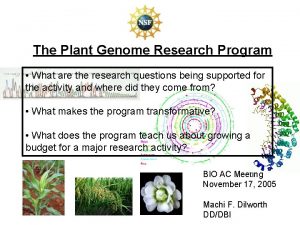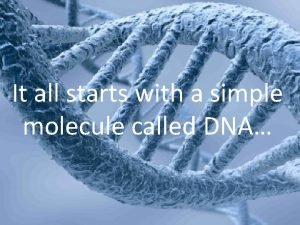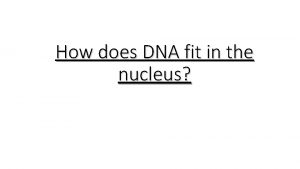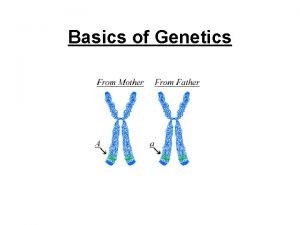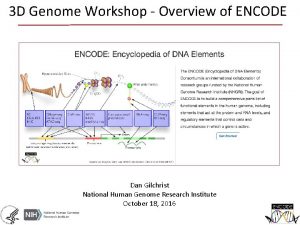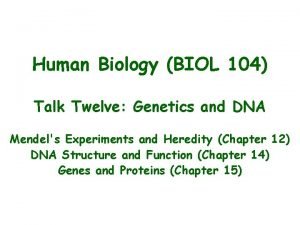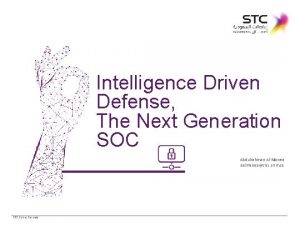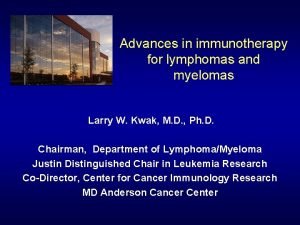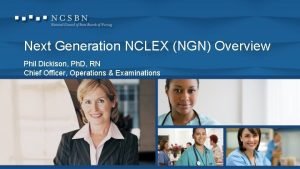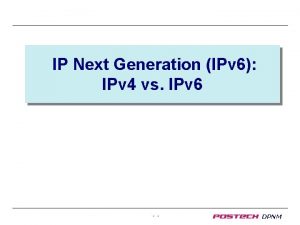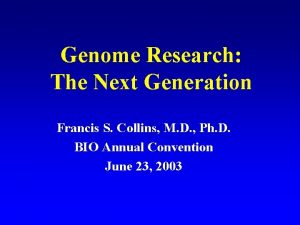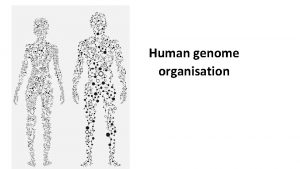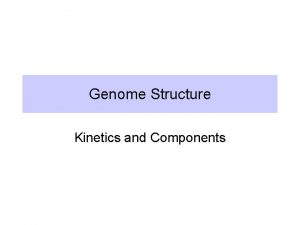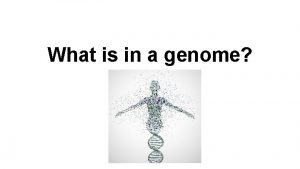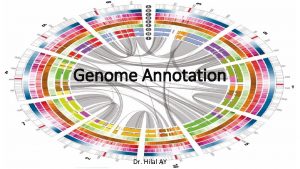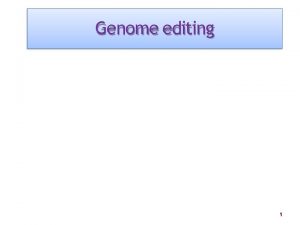Genome Research The Next Generation Francis S Collins






























- Slides: 30

Genome Research: The Next Generation Francis S. Collins, M. D. , Ph. D. BIO Annual Convention June 23, 2003





Collins et al. , Nature 4/24/03

Genomics to Biology • Define the structure of human variation: the human haplotype map • Sequence lots of additional genomes • Develop new technologies for sequencing, genotyping, expression analysis, and proteomics • Identify all functional elements of the genome • Identify all the proteins of the cell, and their interactions • Develop a computational model of the cell


The International Haplotype Map Consortium • Goal is to define common haplotypes covering 80 – 90% of the human genome • Will use 270 samples: West African (Yoruban), East Asian (Japanese and Chinese), and European (CEPH) • Emphasis on community engagement • First phase will be to genotype 600, 000 SNPs with m. a. f. >5%, by early 2004 • Strong focus on QA/QC • All data will be publicly accessible • Ultimately, haplotype tag SNPs will allow genome-wide association studies at 30 – 40 times less cost


Genomics to Biology • Define the structure of human variation: the human haplotype map • Sequence lots of additional genomes • Develop new technologies for sequencing, genotyping, expression analysis, and proteomics • Identify all functional elements of the genome • Identify all the proteins of the cell, and their interactions • Develop a computational model of the cell

Quantum Leaps in Technology • Genotyping at very low cost, allowing whole genome association studies on thousands of DNA samples for $10, 000 or less • Genome sequencing at $1000 or less for a mammalian genome • Synthesis of any DNA molecule at high accuracy for $0. 01 or less per base • Determination of methylation status of all the DNA in a single cell • Determination of the abundance and modification state of all proteins in a single cell in a single experiment

Genomics to Biology • Define the structure of human variation: the human haplotype map • Sequence lots of additional genomes • Develop new technologies for sequencing, genotyping, expression analysis, and proteomics • Identify all functional elements of the genome • Identify all the proteins of the cell, and their interactions • Develop a computational model of the cell

ENCODE Project ENCODE: ENCyclopedia Of DNA Elements Goal: Compile a comprehensive encyclopedia of all functional elements in the human genome Initial pilot project: 1% of human genome Apply multiple approaches to study and analyze that 1% in a consortium fashion Develop and test high-throughput technologies

ENCODE Functional Elements Protein-Coding Genes Non-Protein-Coding Genes Pseudogenes Transcriptional Regulatory Elements Chromosomal Structural Elements Others

ENCODE Consortium Open to all academic, government, and private-industry investigators Utilize both laboratory and computational methods for identifying all functional sequences Initial focus on the selected 1% target, but also aim to scale up for entire genome Common targets, databases, reagents, data access

Genomics to Biology • Define the structure of human variation: the human haplotype map • Sequence lots of additional genomes • Develop new technologies for sequencing, genotyping, expression analysis, and proteomics • Identify all functional elements of the genome • Identify all the proteins of the cell, and their interactions • Develop a computational model of the cell

Collins et al. , Nature 4/24/03

Genomics to Health • Identify the genetic and environmental risk factors for all common disease • Develop “sentinel systems” for early detection of disease and molecular taxonomy of illness • Develop and deploy high-throughput robotic screening of small molecules for academic researchers • Catalyze development of large human cohorts for genotype-phenotype correlations • Elucidate the role that genomics can play in reducing health disparities • Utilize genomics to improve health in the developing world

Creating the Human Genome Translation Toolbox Databases Small molecules c. DNA collection Transcriptome Reference Set si. RNAs KO mouse database

Chemical genomics initiative is enabled by recent developments in biology and chemistry • Fundamentally new paradigm of scope required to assign function to the genome • Access to small molecules for fundamental biology (academia) or validation (Pharma) is limited in both settings • Four convergent developments in last 5 yrs make initiative possible HGP Combinatorial Chemistry Abundance of targets Compound Brokers Availability of compounds Public sector screening and chemistry initiative Automation Technology Ability to screen

Cumulative Cost Probability of success The drug development pipeline Current Public Sector Science Dedicated Med. Chem begins Indefinite Target identification 1 yr Compound accepted into Development ~ 3 yrs Lead Optimization, Toxicology Assay develop- Screening (HTS or Limited ment otherwise) Med. Chem 1 yr 2 yrs Ph II (Safety) (Dose finding, initial efficacy in patient pop. ) 2 -4 yrs Ph III (Efficacy and safety in large populations) Indefinite Ph IV-V (Additional indications, Safety monitoring)

Cumulative Cost Probability of success The drug development pipeline Access to small molecule tools on the scale of Pharma will have a transformative effect on basic biomedical research, speeding functionation of the genome and development of new therapies Proposed Public Sector Science Dedicated Med. Chem begins Indefinite Target identification 1 yr Compound accepted into Development ~ 3 yrs Lead Optimization, Toxicology Assay develop- Screening (HTS or Limited ment otherwise) Med. Chem 1 yr 2 yr Ph II (Safety) (Dose finding, initial efficacy in patient pop. ) 2 -4 yr Ph III (Efficacy and safety in large populations) Indefinite Ph IV-V (Additional indications, Safety monitoring)

Collins et al. , Nature 4/24/03

Genomics to Society • Enhance genetic privacy and protection against genetic discrimination • Encourage appropriate patenting and licensing practices to benefit the public • Understand the relationship of genomics, race, and ethnicity, and bring this to bear usefully on the often contentious dialog about race • Assess the ramifications of advances in understanding genetic factors that influence behavior • Define boundaries of the appropriate application of genomics in the non-medical arena

Genetic Non-Discrimination Act of 2003 • Covers both health insurance and the workplace, as supported by BIO • Support is bipartisan; passed the Senate HELP Committee unanimously • Expected to be voted on by the full Senate in the near future • Supported by the Bush Administration • House status much less certain

Genomics to Society • Enhance genetic privacy and protection against genetic discrimination • Encourage appropriate patenting and licensing practices to benefit the public • Understand the relationship of genomics, race, and ethnicity, and bring this to bear usefully on the often contentious dialog about race • Assess the ramifications of advances in understanding genetic factors that influence behavior • Define boundaries of the appropriate application of genomics in the non-medical arena

Collins et al. , Nature 4/24/03


www. genome. gov
 Semi-global alignment
Semi-global alignment X.next = x.next.next
X.next = x.next.next Plant genome research program
Plant genome research program National human genome research institute
National human genome research institute National human genome research institute
National human genome research institute Codom
Codom National human genome research institute
National human genome research institute Ap biol
Ap biol Genome research limited
Genome research limited First generation antipsychotics
First generation antipsychotics You are good and your mercy endureth forever
You are good and your mercy endureth forever Next generation security platform
Next generation security platform Global next generation wireless communication market
Global next generation wireless communication market Ncsbn clinical judgment model
Ncsbn clinical judgment model Next generation soc
Next generation soc Blaockchain
Blaockchain Next generation vaccine
Next generation vaccine Vendor management matrix
Vendor management matrix Next generation learning platform
Next generation learning platform Palo alto networks next generation security platform
Palo alto networks next generation security platform Next generation text service
Next generation text service Phil dickison
Phil dickison Next generation electrical technologies
Next generation electrical technologies Nextgen electronic medical record
Nextgen electronic medical record Ip next generation
Ip next generation Next generation backup
Next generation backup Educating the next generation of leaders
Educating the next generation of leaders Ngn
Ngn Next generation content management system
Next generation content management system Nys next generation math standards
Nys next generation math standards Next generation trading
Next generation trading


